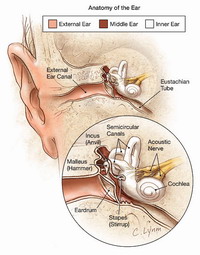Login form
Ears and Hearing
 You have an ear on each side of your head. Your ears let you hear sounds. You can hear music and other nice sounds. You can hear sirens and other warning sounds.
You have an ear on each side of your head. Your ears let you hear sounds. You can hear music and other nice sounds. You can hear sirens and other warning sounds.
Your ears do something else very important. They help you keep your balance. You can walk and ride a bike without falling over because of your ears.
HOW DOES SOUND WORK?
Anything that moves back and forth makes sound. Moving back and forth is called vibrating. Pluck a guitar string and watch it vibrate back and forth. The vibrations make sound waves.
Sound waves are a lot like water waves. If you throw a pebble in a lake or pond, you can see the waves move out in circles. Sound waves move out in circles from whatever is vibrating.
Most sound waves you hear travel through air. Sound waves can also travel through water and even through solid things. You can hear your own voice because your solid skull bones vibrate.
Your ears pick up the sound waves. Your ear has three main parts that let you hear. The parts are called the outer ear, middle ear, and inner ear.
THE OUTER EAR
Your outer ear is the part that sticks out on the side of your head. The outer ear collects sound waves. The sound waves travel down a tube to your eardrum. Your eardrum is a thin layer that separates the outer ear from the middle ear. The sound waves make your eardrum vibrate.
THE MIDDLE EAR
Your middle ear is inside your head on the other side of your eardrum. Your middle ear has three tiny bones. Your vibrating eardrum makes the bones move. The bones carry the vibrations to your inner ear.
Your middle ear is filled with air. A tube connects your middle ear with your nose and throat. This tube helps keep too much air from building up inside your ear. The tube makes your ears pop in an elevator or airplane.
THE INNER EAR
Your inner ear has many parts and tubes that twist and turn. A part called the cochlea is very important for hearing. The cochlea looks like a snail shell. It is filled with fluid and tiny hairs. The moving bones in your middle ear make the fluid and tiny hairs in the cochlea move.
The tiny hairs link to nerves. The nerves carry signals to your brain. Your brain tells you what the sound is. It tells whether you are hearing a train whistle or a bird singing.
HOW DO EARS HELP WITH BALANCE?
Your sense of balance comes partly from your inner ear. Fluid, tiny hairs, and small grains of minerals in your inner ear work together to tell your brain where your head is. They tell your brain if your head is straight up-and-down or sideways. This helps your brain tell your muscles how to move to keep your balance.
Problems with the inner ear can cause dizziness. Motion sickness, such as seasickness or carsickness, comes from your inner ear. When big waves shake you up, the liquid inside your inner ear sloshes around. That can make you feel sick.
WHAT CAUSES HEARING PROBLEMS?
Sometimes people are born with hearing problems. Injuries and infections can also cause hearing problems. People with hearing problems hear less well than others. People with very serious problems cannot hear any sounds. They are totally deaf (unable to hear).
Hearing problems can come from injured eardrums. Infections or other diseases can damage parts of the ear. Cancer can damage nerves. Children can be born with a missing or damaged cochlea or other ear parts. Some people slowly lose their hearing as they get older. Loud music and other loud noises can also cause hearing loss.
Doctors treat ear infections with medicines or use tubes to drain the ear. Ear doctors can give some people hearing aids, small machines that make sounds louder. They can give people with very serious hearing loss a cochlear implant. The implant is a tiny artificial cochlea that changes sound waves to signals. The signals are fed to the nerves that lead to the brain.
Source: Microsoft ® Encarta

